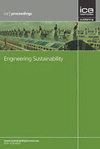Environmental impacts of drilled shafts in sand
IF 1.5
4区 工程技术
Q3 ENGINEERING, CIVIL
Proceedings of the Institution of Civil Engineers-Engineering Sustainability
Pub Date : 2022-04-21
DOI:10.1680/jensu.21.00091
引用次数: 2
Abstract
Geotechnical constructions involve consumption of vast amount of nonrenewable natural resources, and energy- and carbon-intensive materials (e.g., cement and steel) that contribute significantly to global warming and climate change. This paper uses drilled shaft as an example to illustrate the importance of environmental impact assessment in the design phase of foundations. Life cycle assessment (LCA) is used to quantify the environmental impacts of construction of single drilled shafts and groups embedded in sandy soil profiles. Parametric studies are conducted to investigate the effects of soil properties, design parameters, and hauling distances of construction materials and equipment on the environmental impacts of single drilled shafts. For pile groups, different configurations, applied load, center-to-center spacing, and thickness of pile cap are considered in the parametric study. The global warming impact and human toxicity of a typical drilled shaft is found to be 39% and 486% of annual world impact per person, respectively. Based on the study, charts and tables are developed that may be used for quick estimation of global warming impact of drilled shafts without the use of specialised LCA software programs.砂中钻井井对环境的影响
岩土工程涉及消耗大量不可再生的自然资源,以及能源和碳密集型材料(如水泥和钢铁),这些材料对全球变暖和气候变化有重大影响。本文以钻孔竖井为例,说明环境影响评价在基础设计阶段的重要性。采用生命周期评价(LCA)方法,对砂土剖面中单钻井和群施工的环境影响进行了量化。进行参数化研究,以调查土壤性质、设计参数、建筑材料和设备的运输距离对单钻竖井环境影响的影响。对于桩群,参数化研究中考虑了不同构型、外加荷载、中心间距和桩承台厚度。一个典型的钻井井对全球变暖的影响和对人类的毒性分别占全球人均年影响的39%和486%。在研究的基础上,开发了图表和表格,可用于快速估计钻井井对全球变暖的影响,而无需使用专门的LCA软件程序。
本文章由计算机程序翻译,如有差异,请以英文原文为准。
求助全文
约1分钟内获得全文
求助全文
来源期刊

Proceedings of the Institution of Civil Engineers-Engineering Sustainability
ENGINEERING, CIVIL-ENGINEERING, CIVIL
CiteScore
3.70
自引率
16.70%
发文量
44
审稿时长
>12 weeks
期刊介绍:
Engineering Sustainability provides a forum for sharing the latest thinking from research and practice, and increasingly is presenting the ''how to'' of engineering a resilient future. The journal features refereed papers and shorter articles relating to the pursuit and implementation of sustainability principles through engineering planning, design and application. The tensions between and integration of social, economic and environmental considerations within such schemes are of particular relevance. Methodologies for assessing sustainability, policy issues, education and corporate responsibility will also be included. The aims will be met primarily by providing papers and briefing notes (including case histories and best practice guidance) of use to decision-makers, practitioners, researchers and students.
 求助内容:
求助内容: 应助结果提醒方式:
应助结果提醒方式:


